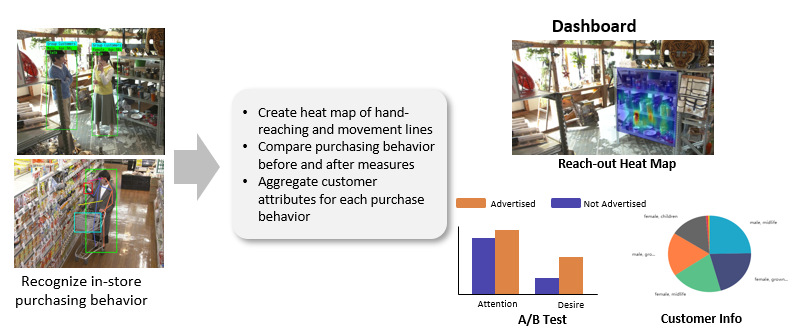
Consumer Behavior Analysis
Visualization of detailed purchasing behavior in real stores, which until now has been a black box.
Supporting the realization of smart stores that provide a personalized customer experience.
Challenges
From measures based on intuition and experience to measures based on data
Improving customer experience in physical stores
・Eases purchase of relevant products
・Improves customer service qualityImplementing measures to improve store sales
・Optimizes placement of merchandise displays
・Investigates and prevents unpurchased products
Solutions
Analysis of purchasing behavior with Actlyzer
・Stopping in front of shelves, looking at products, reaching out, etc.Visualizing interest areas and effectiveness of measures via dashboard
Evaluating the measures based on behavioral data
Strength
Understanding pre-purchasing behavior that is not captured in POS data
Analyzing people-product relationships to support store improvement
Linking with the stock shortage detection function (Available with the next release and on)
Usage Image

Concept Video
Scene 1: Shopping behavior inside a shop
Scene 1 is an example of recognizing the action “One consumer was willing to buy and picked up the product, but after talking to the other, they returned it to the shelf and did not buy it. ”. Actlyzer recognizes a series of actions, from taking the product from the shelf and returning it from the change in image features between the customer's hand with respect to the shelf area. This enables Actlyzer to record non-purchase situations and use them to improve sales floors.
Scene 2: Customer service using a consumer behavioral model
In Scene 2, a store sales assistant delivers a service to the customer at exactly the right moment, using information about their growing desire to purchase based on the association of their behavior and psychological state. There are several specific psychological states before a customer makes a purchase: Attention, Interest, Desire, and Action. Various consumer behavioral models, such as *AIDA, AIDMA, and AIDCA, already exist. But with our relationship-sensing technology, we can now capture a wider variety of situations, ranging from purchase to non-purchase and record them as useful and relevant context.
*AIDA, AIDMA, and AIDCA laws: A model of the psychological states leading to consumer purchasing decisions.
AIDA : Attention ⇒ Interest ⇒ Desire ⇒ Action
AIDMA : Attention ⇒ Interest ⇒ Desire ⇒ Memory ⇒ Action
AIDCA : Attention ⇒ Interest ⇒ Desire ⇒ Conviction ⇒ Action



